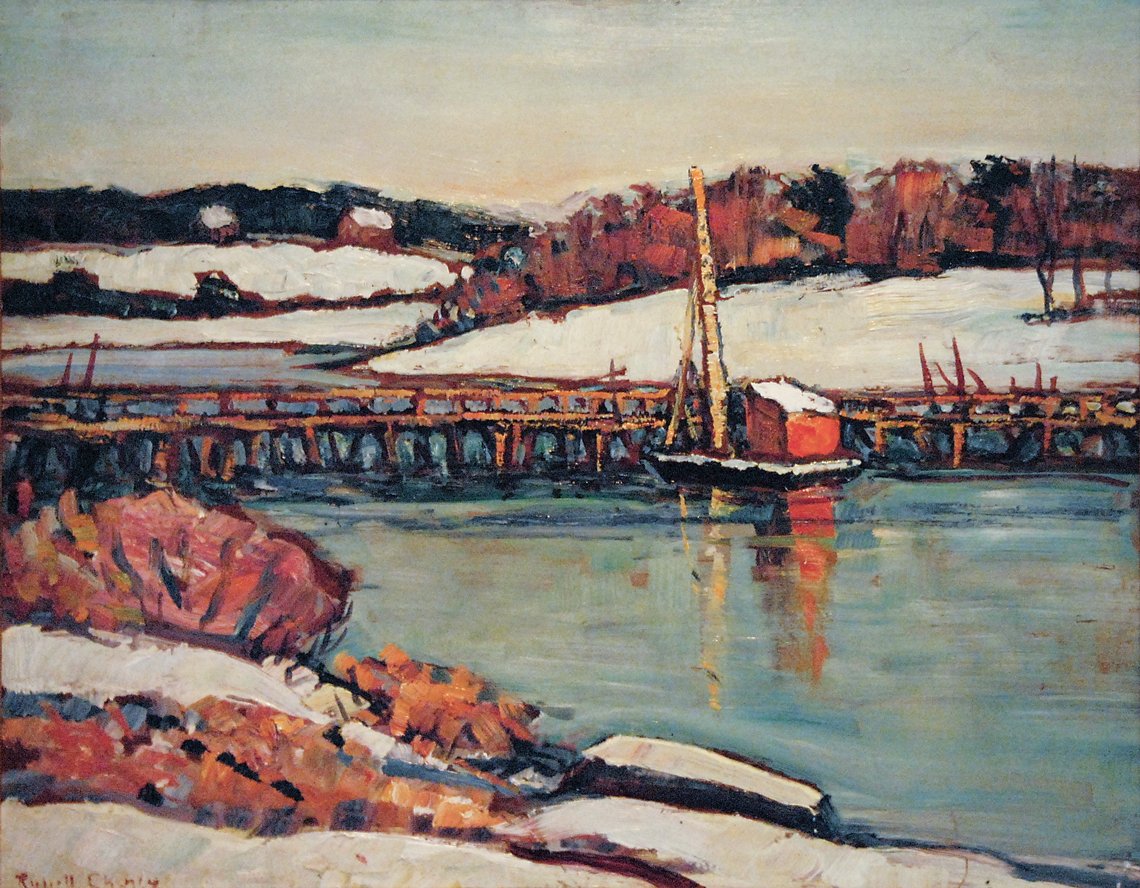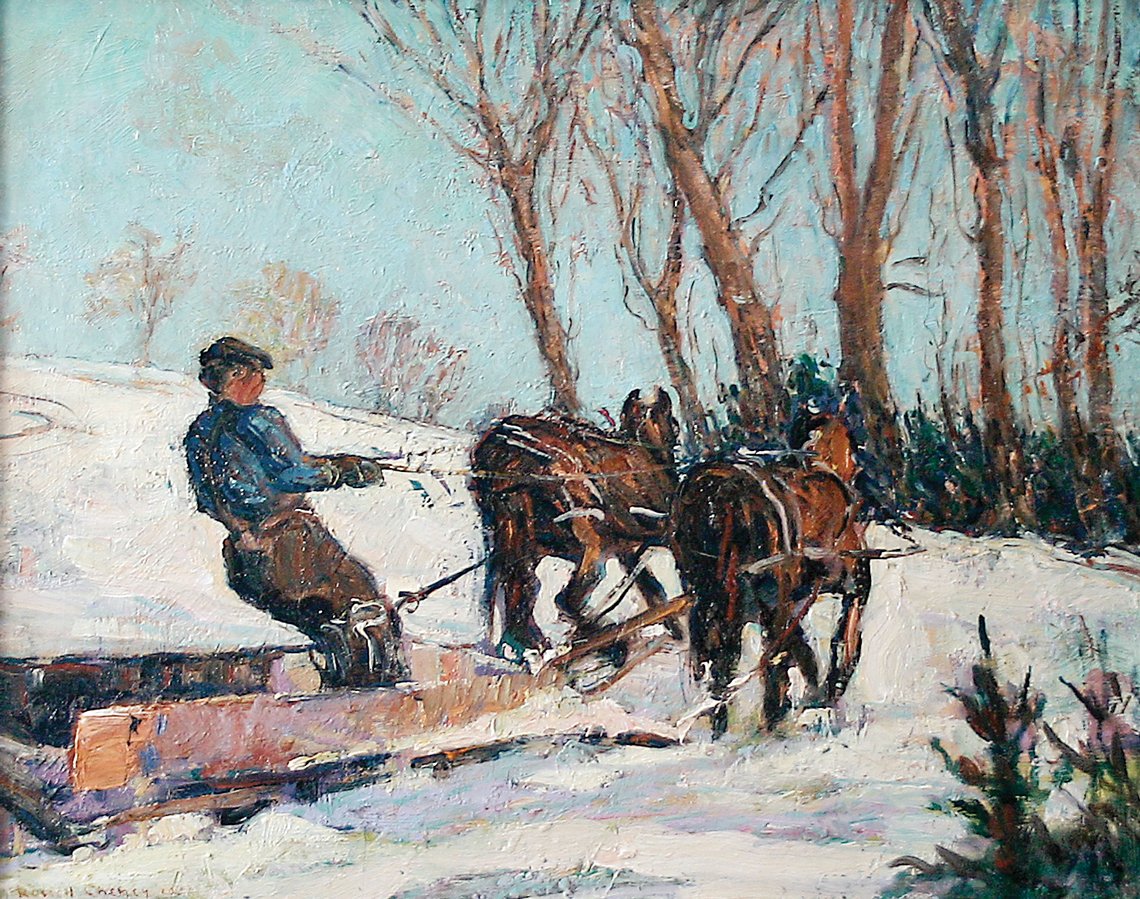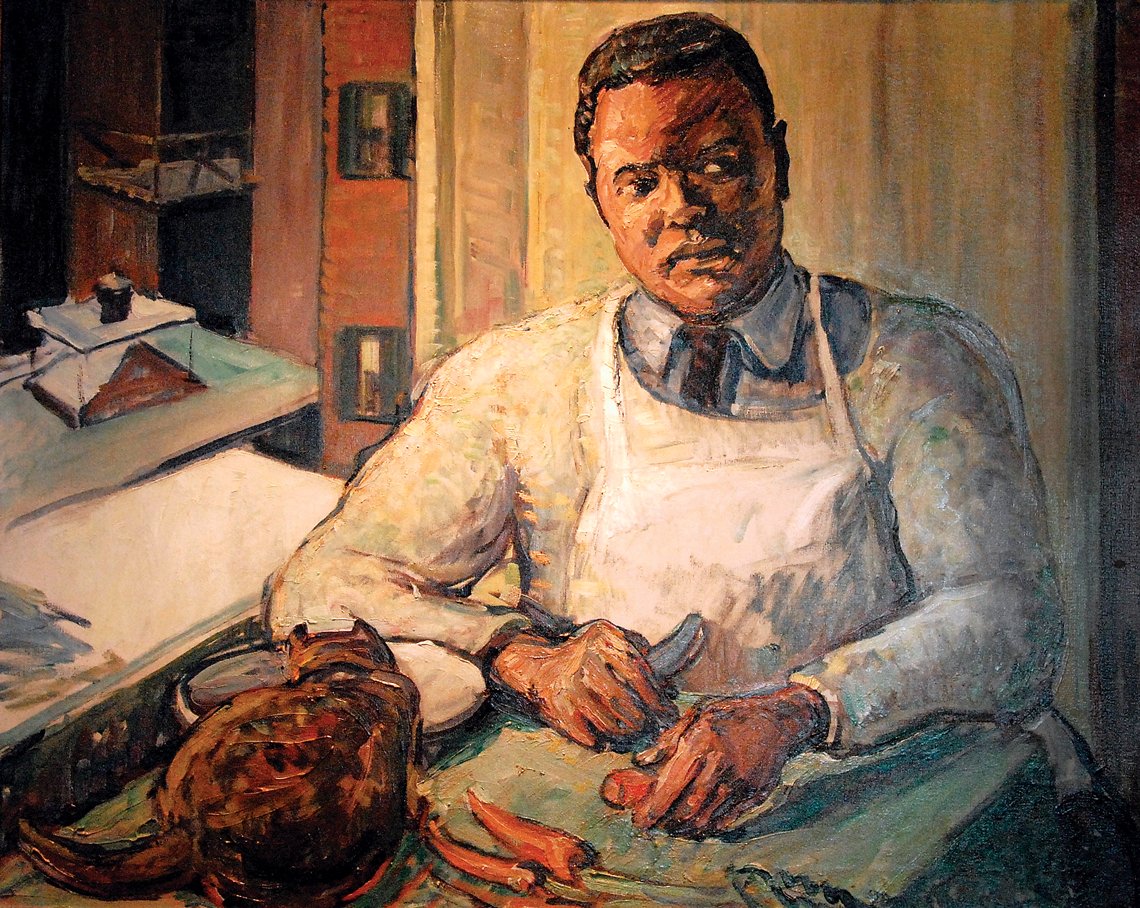Rediscovery of a New England Master Russell Cheney 1881-1945 by Richard M. Candee
 |
Although Russell Cheney was known during his lifetime for his floral paintings, still life work, and landscapes of France, Italy, and the American West, his depictions of his native New England dominate a prolific body of work that ranged widely in style and subject over his thirty-year career. In a review of Cheney's work written after his death in 1945, art critic Dorothy Adlow said, 'It is touching to find the New Englander, world-traveled, well-read, widely-informed, discovering the universal qualities of beauty in rural New England.'1 Research involved in the preparation of a catalogue raisonné and two exhibitions in Portsmouth, New Hampshire, has shed new light on Cheney's New England work.2
 |
Russell Cheney (1881-1945), Down East, ca. 1936. Oil on panel, 18 x 15 inches. Courtesy of the Master of Eliot House, Harvard University. Gift of Barney and Lucy Bowron. |
 | |
| Russell Cheney (1881-1945), Lilies by the Sea, 1936. Oil on canvas, 40 x 27 inches. Private Collection. |
Russell Cheney was born in 1881 into a large family of silk manufacturers in South Manchester, Connecticut. Following family tradition he attended Yale and was admitted to the Skull and Bones society. At Yale he took an elective class in painting but showed no real interest in art until after he graduated in 1904. Moving to New York City, Cheney studied at the Art Students League with Kenyon Cox (1856-1919) and George Bridgman (1865-1943) until 1907. He continued his art education in Paris under Jean Paul Laurens (1838-1921) at the Académie Julian. After his father's death in 1908, he returned home and worked with Cox and William Merritt Chase (1849-1916) at the Art Students League. In 1909 Cheney was elected president of the League (the same year he exhibited at the Salon des Artistes Francais); although he resigned a year later, he continued to take classes there, studying with Chase as a private pupil.
Cheney's artistic training continued for nearly two decades. While he frequently mentioned his most illustrious teachers, it is now known that he also took lessons from Portland, Maine, artist Walter Griffin (1861-1935) at the Hartford Art Society. Cheney was one of three 'former pupils' who went to Portland in either 1909 or 1910 to see Griffin off on a voyage to Norway.3 In 1923-24 the two men reconnected in Paris, where Griffin continued to mentor the younger artist.
 |
| Russell Cheney (1881-1845), Bridge in Water, ca. 1939. Oil on panel, 20 x 15-3/4 inches. Courtesy of a Private Collection. |
 |
| Russell Cheney (1881-1945), Piscataqua River, ca. 1931. Oil on canvas, 41 x 33-3/4 inches. Courtesy of Carol L. Cheney. |
 | |
| Russell Cheney (1881-1945), White Birches, 1915. Oil on canvas, 27 x 27 inches. Courtesy of Carol L. Cheney. |
Cheney spent the summers between 1911 and 1914 painting in York and nearby Ogunquit, Maine. In 1912 he studied there with Charles Woodbury (1864-1940), who continued to provide Cheney with helpful criticism for several more years. That fall Cheney wrote to his favorite niece, Helen Bayne, 'I must say I am getting a lot of work done. There is no one else in the place I stay at so I am not much bothered with talking — I like it and my hen-house [studio] is the cheerfulest place you ever saw.4 His Pine Trees, Ogunquit, Maine, (1913) was shown at the Fourth Annual Exhibition of the Connecticut Academy of Fine Arts in 1914, his first known American exhibition. That same year he mounted a one-man exhibition at the Hartford Art Society, where he showed several scenes of the Manchester, Connecticut, area, in addition to French and California subjects and floral studies. Over the next few decades Cheney would strengthen his association with Hartford via seven exhibitions held at the city's Wadsworth Atheneum. In 1916 he was admitted to the Connecticut Academy of Fine Arts, where he exhibited White Birches, one of several brilliantly colored local landscapes he painted that year.
Little was known of Cheney's early career until August 2004, when a cache of artwork was discovered at Red Echo Farm in Topsham, Vermont, a hillside apple farm owned by Charles Macdonald (1884-1961). Subsequent auctions from the same house a year later brought forth correspondence and photographs that have provided a better understanding of the artist's development. Among several unframed oils on canvas and artist board to emerge from the auctions were studies of Ogunquit, Maine, and Rockport, Massachusetts, as well as many plein air views of the farm and Topsham, painted between 1916 and 1921.
 |
| Russell Cheney (1881-1945), Halibut Point, Rockport, ca. 1916-20. Oil on canvas, 16 x 20 inches. Courtesy of a Private Collection. |
 |
| Russell Cheney (1881-1945), Red Echo Farm, Topsham, Vermont, 1918. Oil on panel, 16 x 12 inches. Courtesy of a Private Collection. |
 |
| Russell Cheney (1881-1945), First Snow, 1916. Oil on panel, 16 x 12 inches. Courtesy of Robert S. Chase. |
Macdonald purchased Red Echo Farm in 1912. That fall his sister, Evelyn Barrett Macdonald, started classes at the Art Students League, where her residence was listed as the Hotel Seville at Madison Ave and 29th Street. This was only two blocks away from the 31st Street home of Thomas Cheney, Russell's older brother, with whom he then lived. In January 1915, Evelyn Macdonald and Russell Cheney enrolled in Frank Vincent DuMond's 'Life Drawing and Painting' class, presumably in different studios, as life drawing classes were held separately for men and women. While this was Cheney's last class there, Macdonald continued her studies through spring 1920, after which she moved to her brother's Vermont farm.5
Through his connection to Evelyn, Cheney came to Red Echo Farm in part to counteract symptoms of the tuberculosis that had forced him into a Colorado sanatorium for much of 1916 to 1918. First Snow, the oldest of several paintings executed at Red Echo Farm, is dated 1916; another view of the farm house is inscribed to Charles Macdonald in 1918. In August 1919, writing to the poet H. Phelps Putnam (Yale 1916), Cheney confided that he, painted good in Vermont — saved 14 out of 15 canvases.'6 Shown in a January 1920 exhibition at the Portland Art Museum, a local reviewer called the now-lost Vermont Valley — loaned by fellow Yale Bonesman, Winthrop Murray Crane Jr. of the Crane Paper Company — 'a gem and one of the fine things of the exhibition.'7 An oil study and many seasonal variations of this mountainous view of Red Echo Farm are also known. His December 1920 show at the Wadsworth Atheneum also included Sawing Wood, a painting of Four Corners Farm, later Evelyn Macdonald's Vermont home.
 |
| Russell Cheney (1881-1945), Sugaring Time, 1920. Oil on canvas, 17 x 21 inches. Courtesy of David Kaselauskas. |
 |
| Russell Cheney (1881-1945), Kittery Point, 1927. Oil on canvas, 29 x 36 inches. Courtesy of a Private Collection. |
 |
| Russell Cheney (1881-1945), Piscataqua Lane, New Castle, NH, ca. 1933-36. Oil on canvas, 24 x 30 inches. Signed lower right. Courtesy of Manchester Historical Society, Manchester, Connecticut. |
Cheney's main studio was a converted stable behind his family home in South Manchester; here, in 1920, he 'painted a big farming picture, a sort of combination of other Vermont canvases,' as he wrote Putnam in a letter dated August 2 of that year. Another 1920 Vermont work was called Sugaring Time, or Sugaring, when shown in his first New York City exhibit in December 1921. The Sun commented, 'It must have been sport to paint the action of 'Sugaring.' But then almost all of Mr. Cheney's canvases look as though he had pleasure in doing them.'8 When Charles Macdonald saw the exhibition catalogue, he wrote his sister, 'apparently 1/5 of the whole show is Topsham — pretty good considering that he has spent much less than 1/5 of his life since a painter here.'9 Cheney's extended visits to Red Echo Farm ended soon after he was best man in Macdonald's 1921 wedding.
Cheney's postimpressionist style evolved during trips to Europe in 1923 and 1926. In 1927, returning to New England, he rented a summer home at Kittery Point, Maine. 'Kittery Point is the most paintable place I have ever seen,' the artist told a reporter in 1928, claiming that his work here would 'surpass the foreign things' he had previously painted. Cheney also remarked — as other American artists were discovering — that 'The average buyer of paintings wants subjects from his own country. He buys something he will want to look at for a long time. American scenes are more satisfying to him.'10 In Kittery, he began to paint the landscape in new ways. Leaving impressionism behind, over the next decade he became a grounded 'Yankee modernist.'
 |
| Russell Cheney (1881-1945), From Peirce's Island, 1939. Oil on canvas, 30 x 20 inches. Courtesy of Joseph W. P. Frost. |
 |
| Russell Cheney (1881-1945), Hauled Up, 1937. Oil on canvas, 21 x 26-1/16 inches. Courtesy of Yale University Art Gallery; gift in memory of Francis O. Matthiessen, B.A. 1923 in memory of the artist. |
 | |
| Russell Cheney (1881-1945), Depot Square, ca. 1931. Oil on canvas, 40 x 22 inches. Dorothy Vaughan Collection, New Hampshire Historical Society. |
The modern quality of this new work was recognized by T. H. Parker in his review of Cheney’s 1927 Hartford exhibit published in the Hartford Time. Parker called it, 'the best exhibition of landscapes in oil that have come to this city in a very long time.' Cheney's paintings, he continued, 'are distinguished by utmost simplicity and directness. They are not cluttered up by modeling and...place the artist in the Cézanne discipleship. Their simple structure, their facile coloring, their form, make for a calm, sure, and uncloying art.'11
With the crash of 1929 and ensuing Great Depression, Cheney's income disappeared. The Cheney family silk mills had been losing money steadily for years and declared a 1930 dividend only because so many family members were entirely dependent on it. When the company stopped paying entirely in August of that year, Cheney was dependent on the income of his partner, Harvard professor, historian, and literary critic, F. O. Matthiessen (1902-1950), whom he had met in 1924. In 1930 the two men purchased a small house on Old Ferry Lane in Kittery. Elements of the house and gardens as well as a separate studio built on the lot for Cheney were included in a number of his still-life paintings.12
 |
| Russell Cheney (1881-1945), Nelson Cantave, 1940. Oil on canvas, 36 x 29 inches. Courtesy of a Private Collection. |
Cheney continued an active exhibition schedule during the 1930s. Chick Austin, director of the Wadsworth Atheneum from 1927 to 1944, showed Cheney's work along with that of Milton Avery and other younger moderns in 1930. Between 1930 and 1941 Cheney frequently exhibited at the Ogunquit Art Association in Maine, at local venues on either side of the Piscataqua River, and in group exhibitions at the Addison Gallery of American Art at Phillips Academy Andover. When Addison Gallery Director Charles Sawyer began a series of contemporary New England one-man shows there in 1934, Cheney was his first choice.
 | |
Russell Cheney (1881-1945), Doorstop, 1941. Oil on canvas, 20 x 36 inches. Courtesy of Robert S. Chase. |
These exhibits featured subjects not only from southern Maine, but of New Castle village and Portsmouth, New Hampshire, across the river. From Peirce's Island, 1939, is one of many views of Portsmouth's waterfront neighborhoods. This was one of a number of scenes Cheney painted during and after the Depression that reflected economic hardships: images showing idle factories without the billowing smoke emblematic of active plants, or the means of earning a living, as with the dormant fishing boat in Hauled Up.
In 1934 Cheney began to exhibit his work almost annually at Grace Horne Galleries in Boston, while continuing to mount exhibits in New York City at the Montross Gallery (from 1928 to 1934) and Ferargil Galleries (from 1936 to 1941). In these markets he exhibited such works as Depot Square and portraits of friends. One of the most engaging is of Nelson Cantave, his Haitian-born cook. Seated in Matthiessen's apartment in Boston, the image was painted in 1940, soon after Cantave's marriage and relocation to Portsmouth to work in the kitchen of the Naval Shipyard. The portrait opened Cheney's last show at Ferargil during his lifetime.
After Cheney died of a heart attack in 1945, sixty-nine of his canvases were loaned for informal memorial tributes to him at the Portland and Colby College art museums. Two years later, in 1947, Matthiessen arranged a retrospective of thirty major works at Ferargil Galleries and the Wadsworth Atheneum. Later that year Meeting House Hill, Doorstop, and Pepperrell Cove were all among his New England images shown in an exhibit at Boston's Institute of Modern Art, which included works by Cheney, Marsden Hartley (1877-1943), and Carl Gordon Cutler (1873-1945), three other recently deceased New England artists. In a review of the Boston exhibition, Lawrence Dame said of Cheney, 'He spent the last fifteen years of his life painting in Kittery, Me., where he came to love the natives. And they loved him. Having slipped away from Cézanne and Childe Hassam, Cheney turned to strong, revealing portraits, bold depictions of mountains, fields and sea which stressed the calm and beautiful aspects of each.'13
Between 1914 and his death in 1945, Russell Cheney participated in sixty-nine one-man shows and was included in more than eighty group exhibitions. Research has uncovered documentation for 936 works. Of these, 459 have been located; 382 are oil paintings, 72 are oil studies on panel or canvas. Two are watercolors, and two are pastels, while 102 works are known only from old black and white photographs and the remaining 376 only by exhibition title. Anyone knowing of other works by the artist is invited to contact the author at www.russellcheney.com.
1. Christian Science Monitor, April 3, 1947.
2. Manuscript materials about Cheney are in the Phelps Putnam, Farwell Knapp, and F. O. Matthiessen Papers at Beinecke Library, Yale University. Many are quoted in F. O. Matthiessen, Russell Cheney (1881-1945) A Record of his Work (New York and London: Oxford University Press, 1947) and in Rat and the Devil: Journal Letters of F. O. Matthiessen and Russell Cheney, Louis Hyde, ed. (Hamden, CT: Archon Books, 1978). Also see Frederic Newlin Price, Russell Cheney 1881-1945 Retrospective Memorial Exhibition March 17 to 29, 1947, and Patricia Heard, Russell Cheney (1881-1945) Artist of the Piscataqua (Portsmouth, NH: Portsmouth Athenaeum, 1996).
3. Undated newspaper clipping, Walter Griffin collection, Maine Historical Society, Portland, ME.
4. Russell Cheney to Helen Bayne, Oct. 8, 1912, Farwell Knapp Papers, Beinecke Library, Yale University.
5. I thank Stephanie Cassidy, archivist, Art Students League, NYC, for her research help.
6. Cheney to Putnam, Aug. 11, 1919. Beinecke Library, Yale University.
7. Portland Sunday Telegram, Jan. 25, 1920.
8. The Sun, NYC, Dec. 17, 1921.
9. Charles Macdonald to Evelyn B. Macdonald, Dec. 14, 1921. E.B. Macdonald papers in the possession of the author.
10. Portland Press Herald, Sunday, Oct. 14, 1928.
11. Hartford Times, Nov. 19, 1927
12. Farwell Knapp diary, June 11, 1930, p. 64; Aug. 9, 1930, p. 124-5; Aug. 22, 1930, p. 140, in Knapp Papers, Beinecke Library, Yale.
13. Lawrence Dame, 'Regarding Art' unidentified clipping, Sept. 28 (Sunday) 1947, Matthiessen Papers, Beinecke Library, Yale.
Richard M. Candee is Professor Emeritus of American and New England Studies at Boston University, where he long served as Director of the Preservation Studies Program, and a joint MA/JD on Preservation and the Law. From 1969 to 1976 he was architectural historian at Old Sturbridge Village for a regional survey of New England textile mills. He would like to thank Carol L. Cheney for her assistance and support.
This article was originally published in the Summer 2008 issue of Antiques & Fine Art magazine, a fully digitized version of which is available at www.afamag.com. AFA is affiliated with Incollect.com.
 |



























